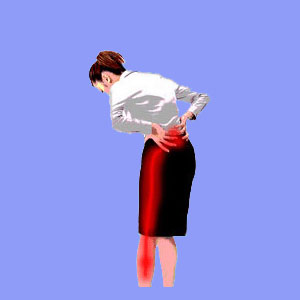
Many patients have difficulty finding the words to adequately describe their sciatica suffering. Lower back and leg pain is an epidemic condition which takes a huge toll on the workplace, since it is the #1 reason for an employee to miss time on the job. However, this cost is nothing compared to the emotional and physical toll the condition takes on a patient’s quality of life.
This article will take a look at the human casualties enacted by sciatica. We will explore how chronic suffering can cause a life to go into an uncontrolled downward spiral and provide patients some insights to get back on the path towards better health.
Acute Sciatica Suffering
Acute sciatica is a torturous pain syndrome which can strike at any time and completely cripple a patient with blindingly furious symptoms.
Recurrent bouts of acute sciatic nerve pain make it very difficult to make future plans, since a patient never really knows when they will be struck down with debilitating agony.
Acute bouts of sciatica also make it virtually impossible to find a comfortable position. Many patients can not sit, stand, walk or even recline without feeling the constant surging radicular pain coursing through their lower limbs.
Working, playing or even spending quality time with family and friends are extremely limited, due to the burden of severe and frequent symptomatic events.
Chronic Suffering
While acute attacks of nerve pain are bad, there is nothing worse than chronic sciatica. Pain which endures 24/7, every day, every week, every month, every year creates a truly hellish existence.
Chronic sciatica patients have a constant companion in life; their pain. They greet the pain first thing in the morning and say goodnight to it as their last thought at night. That is, if their pain is kind enough to actually allow them to get some sleep.
Chronic suffering from sciatic nerve symptoms is often a permanent concern for the majority of patients who experience discomfort for more than 1 year. In fact, statistics show that if pain still exists after one year, it has a better chance of lasting for life than of actually being completely cured. This is a chilling factual statistic.
Surviving Sciatica Suffering
I know all too well what it is to suffer. I began my painful journey at the innocent age of 16. My first chiropractor set the stage for a protracted pain syndrome when he imparted a very powerful nocebo effect on me through his unsympathetic and unrealistic diagnostic process. He blamed my first back and leg pain symptoms on scoliosis, muscle imbalances and degenerative disc disease. I was devastated by this diagnosis and could not understand how my spine was so damaged at such a young age. It is no surprise that my pain only intensified after seeing this doctor.
Well, this chiropractor was just the beginning of an epic quest to find relief. Doctor after doctor, with only a few exceptions, added to this nocebo effect by diagnosing 2 herniated discs a few years down the line and recommending a variety of scary and often surgical treatment options. I tried everything to cure my sciatica pain, but nothing worked.
I eventually became obsessed with my symptoms which turned chronic by my late 20s. From that time on, there was not one day in my life in which I did not suffer, physically and emotionally, from my dire sciatica and lower back pain.
I was very lucky. I came across an alternate explanation for my pain which turned out to be the magic bullet I needed to find recovery. I was able to cure my own pain 100% using the easy and sensible knowledge therapy approach after consulting with Dr. John Sarno of the Rusk Institute of Rehabilitation Medicine/NYU Medical Center. This treatment banished my long standing pain in a matter of weeks.
Since then, I have devoted my life to helping others find a cure for their own pain. I have been given an amazing gift: The gift of health. There is nothing more precious or valuable in the entire world. I hope to share this gift with as many patients as possible. All these years later, I am still inspired to help others. Please know that I will never rest while any of us continue to suffer. Instead, I will continue my patient advocacy work to make the treatment process better for all of us and hopefully provide a few patients with the tools they need to find their own lasting cures.





